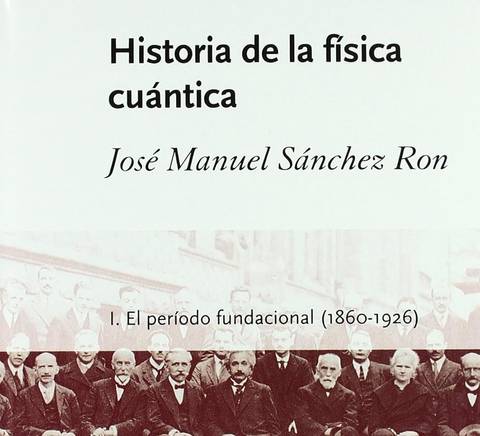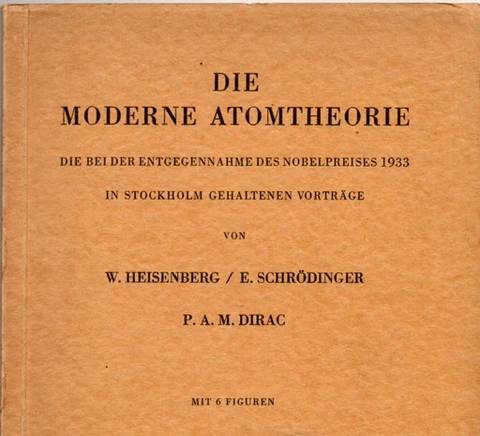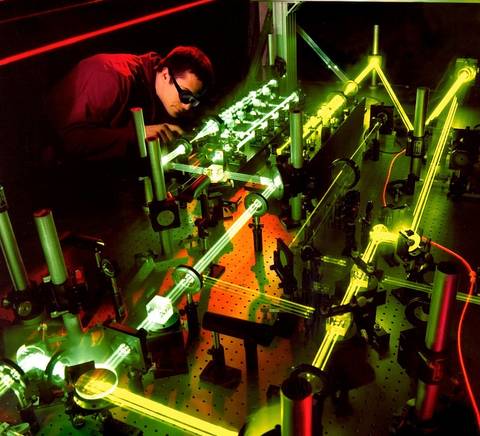Comentario bibliográfico
El servicio de Biblioteca presenta una selección bibliográfica diseñada para destacar la relevancia de esta efeméride, integrando los aspectos históricos, tecnológicos y de divulgación científica. Se trata de una muestra que no sólo conmemora un siglo de avances en la ciencia, sino que también busca fomentar el interés por el conocimiento y el compromiso con la investigación y la innovación tecnológica, valores que distinguen la celebración de la Semana de la Ciencia en la Universidad Pontificia Comillas, a la vez que visibilizar su magnífico fondo patrimonial.
La exposición se articula en tres secciones, que invitan al visitante a descubrir obras fundamentales de las figuras que sentaron las bases de la mecánica cuántica, a conocer algunas de las primeras aplicaciones tecnológicas impulsadas por los principios cuánticos y finalmente a explorar publicaciones recientes que abren nuevas perspectivas sobre el impacto y el potencial de la ciencia cuántica y de la Inteligencia Artificial en la sociedad actual.

La primera sección propone un recorrido por el origen y evolución de la mecánica cuántica dentro del marco de la física cuántica, con monografías relacionadas con su historia, fundamentos teóricos e implicaciones científicas. Entre los títulos expuestos destacamos Historia de la física cuántica de José Manuel Sánchez Ron, obra en varios volúmenes, editada por Ed. Crítica que nos relata la evolución histórica y conceptual de la física cuántica, incluyendo los hitos científicos y las contribuciones de figuras clave que establecieron las bases de la mecánica cuántica moderna, como Planck, Einstein, Bohr, Heisenberg, y Schrödinger, entre otros. Desarrollos que conforman los principios esenciales de la mecánica cuántica, como la cuantización de energía, la dualidad onda-partícula, el principio de incertidumbre y la superposición cuántica.

Continuamos con Die moderne Atomtheorie: die bei der Entgegennahme des Nobelpreises 1933 in Stockholm gehaltenen Vorträge, publicada en Leipzig en 1934, recoge las conferencias pronunciadas por Werner Heisenberg, Erwin Schrödinger y Paul A. M. Dirac al recibir el Premio Nobel de Física en 1933. Conferencias que sintetizan los desarrollos clave que condujeron a la formulación moderna de la teoría atómica basada en la mecánica cuántica.
The Physical Principles of the Quantum Theory (1930) en el que Heisenberg presenta los fundamentos físicos y matemáticos de la teoría cuántica, destacando su propia formulación matricial de la mecánica cuántica y el principio de incertidumbre y Les principes de la mécanique quantique (1931) de Paul Dirac, obra que marcó un antes y un después en la formulación y comprensión de la mecánica cuántica. Publicada originalmente en 1930, introduce de forma rigurosa el marco matemático de la mecánica cuántica, abordando conceptos como el principio de superposición, la función de onda y la novedosa notación de bra-ket, que se convertiría en estándar en la disciplina.

Por su especial interés, se expone Werner Heisenberg (1977) biografía escrita por Carl Friedrich von Weizsäcker y Bartel Leendert van der Waerden, ambos destacados científicos y filósofos de la física, que compartieron época y campo de estudio con Heisenberg y que exploran aspectos importantes de su vida, su pensamiento y su controvertido papel durante el proyecto nuclear alemán en la Segunda Guerra Mundial.

La segunda sección presenta monografías centradas en las aplicaciones tecnológicas cuánticas que han transformado la vida contemporánea, como el transistor, el láser y la resonancia magnética nuclear. Entre los títulos presentados destacamos Revolución en miniatura (1984) de Ernest Braun, obra fundamental que analiza el origen, la evolución y la profunda repercusión en la sociedad y en la tecnología contemporánea de los semiconductores, especialmente el transistor y sus descendientes (los circuitos integrados). Principles of Lasers (1982) de Orazio Svelto, que nos presenta los principios que rigen el funcionamiento de los láseres, partiendo de los conceptos básicos de mecánica cuántica y el electromagnetismo. El láser: la luz de nuestro tiempo (2010), editado por Benjamín Alonso Fernández, texto que aborda el láser como tecnología y fenómeno físico.
Finalmente completan esta sección Aplicaciones de Resonancia magnética en diferentes especialidades médicas y quirúrgicas, (1997) dirigida por Clemente Gómez Pérez y publicada por el Hospital San Rafael, y Aprendiendo los fundamentos de la resonancia magnética (2007), coordinado por Laura Oleaga Zufiría y Javier Lafuente Martínez. Obras que ayudan a entender tanto la práctica clínica avanzada como los fundamentos técnicos de la resonancia magnética médica.

La tercera y última sección quiere destacar el impacto emergente de la computación cuántica y de las tecnologías asociadas, con especial atención a su potencial para revolucionar áreas como la inteligencia artificial, salud, finanzas y ciberseguridad, apoyándose en publicaciones periódicas de referencia internacional como Nature, Science, Physical Review Letters, NPJ Quantum Information, IEEE Transactions on Quantum Engineering y Quantum. Revistas de relevancia internacional que visibilizan los avances más relevantes, generando un alto impacto en la comunidad científica de computación cuántica, tanto desde puntos de vista teóricos como experimentales e ingenieriles.

Esperamos que este recorrido bibliográfico haya permitido al visitante entender no solo la génesis y desarrollo histórico de la mecánica cuántica, sino también sus aplicaciones prácticas actuales y, en lo posible, le haya ayudado a vislumbrar su impacto futuro. Ha sido un gusto para el Servicio de Biblioteca poder colaborar en esta magnífica iniciativa, y desea vivamente que haya sido de su interés.
---
Bibliographic Commentary
The Library Service presents a bibliographic selection designed to highlight the relevance of this anniversary, integrating historical, technological, and scientific outreach perspectives. This exhibition not only commemorates a century of progress in science but also seeks to encourage interest in knowledge, research, and technological innovation—values that characterize the celebration of Science Week at Universidad Pontificia Comillas—while showcasing its magnificent heritage collections.
The exhibition is organized into three sections inviting visitors to discover key works by the figures who laid the foundations of quantum mechanics, to explore some of the first technological applications driven by quantum principles, and finally to review recent publications that open new perspectives on the impact and potential of quantum science and Artificial Intelligence in contemporary society.
The first section offers a journey through the origin and evolution of quantum mechanics within the framework of quantum physics, including monographs related to its history, theoretical foundations, and scientific implications. Among the titles exhibited, we highlight Historia de la física cuántica by José Manuel Sánchez Ron, a multi-volume work published by Editorial Crítica that narrates the historical and conceptual development of quantum physics, including scientific milestones and contributions by key figures who established the foundations of modern quantum mechanics—such as Planck, Einstein, Bohr, Heisenberg, and Schrödinger. These developments constitute the essential principles of quantum mechanics, such as energy quantization, wave-particle duality, the uncertainty principle, and quantum superposition.
We continue with Die moderne Atomtheorie: die bei der Entgegennahme des Nobelpreises 1933 in Stockholm gehaltenen Vorträge, published in Leipzig in 1934, which compiles the lectures delivered by Werner Heisenberg, Erwin Schrödinger, and Paul A. M. Dirac upon receiving the Nobel Prize in Physics in 1933. These lectures synthesize the key developments that led to the modern formulation of atomic theory based on quantum mechanics. The Physical Principles of the Quantum Theory (1930), in which Heisenberg presents the physical and mathematical foundations of quantum theory—highlighting his matrix formulation of quantum mechanics and the uncertainty principle—and Les principes de la mécanique quantique (1931) by Paul Dirac, a groundbreaking work in the formulation and understanding of quantum mechanics. Originally published in 1930, it rigorously introduces the mathematical framework of quantum mechanics, covering concepts such as the superposition principle, the wave function, and the innovative bra–ket notation that would become standard in the discipline.
Of special interest is Werner Heisenberg (1977), a biography written by Carl Friedrich von Weizsäcker and Bartel Leendert van der Waerden, both renowned scientists and philosophers of physics who shared an era and field of study with Heisenberg. The book explores significant aspects of his life, thought, and controversial role in the German nuclear project during World War II.
The second section presents monographs focused on quantum technological applications that have transformed contemporary life, such as the transistor, the laser, and nuclear magnetic resonance. Among the featured titles are Revolución en miniatura (1984) by Ernest Braun, an essential work examining the origin, evolution, and profound societal and technological impact of semiconductors—especially the transistor and its descendants, the integrated circuits. Principles of Lasers (1982) by Orazio Svelto explains the principles governing the operation of lasers, starting from basic concepts in quantum mechanics and electromagnetism. El láser: la luz de nuestro tiempo (2010), edited by Benjamín Alonso Fernández, addresses the laser both as a technology and as a physical phenomenon. Completing this section are Aplicaciones de Resonancia Magnética en diferentes especialidades médicas y quirúrgicas (1997), edited by Clemente Gómez Pérez and published by Hospital San Rafael, and Aprendiendo los fundamentos de la resonancia magnética (2007), coordinated by Laura Oleaga Zufiría and Javier Lafuente Martínez—works that help to understand both advanced clinical practice and the technical foundations of medical magnetic resonance imaging.
The third and final section highlights the emerging impact of quantum computing and its associated technologies, with particular attention to their potential to revolutionize fields such as artificial intelligence, healthcare, finance, and cybersecurity. It features leading international publications such as Nature, Science, Physical Review Letters, NPJ Quantum Information, IEEE Transactions on Quantum Engineering, and Quantum—journals of great international relevance that showcase the most significant advances and exert strong influence on the global quantum computing community, from both theoretical and experimental or engineering perspectives.
We hope that this bibliographic journey has allowed visitors to understand not only the genesis and historical development of quantum mechanics but also its current practical applications and, ideally, its future impact. The Library Service is delighted to have contributed to this remarkable initiative and sincerely hopes it has been of interest to all.
